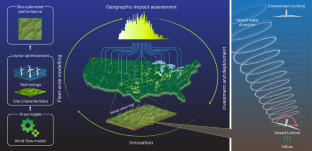2024-05-07 米国国立再生可能エネルギー研究所(NREL)
<関連情報>
- https://www.nrel.gov/news/program/2024/nrel-artificial-intelligence-work-reveals-benefits-to-wind-industry.html
- https://www.nature.com/articles/s41560-024-01516-8
人工知能が風力発電所の最適化を支援し、航跡操舵による土地利用と経済効果を全国規模で評価 Artificial intelligence-aided wind plant optimization for nationwide evaluation of land use and economic benefits of wake steering
Dylan Harrison-Atlas,Andrew Glaws,Ryan N. King & Eric Lantz
Nature Energy Published:22 April 2024
DOI:https://doi.org/10.1038/s41560-024-01516-8

Abstract
If clean energy pathways are to harness massive increases in wind power, innovations with broad geographic viability will be needed to support buildout in diverse locations. However, geodiversity in impact potential is seldom captured in technology assessment. Here we propose a scalable approach to plant-level optimization using artificial intelligence to evaluate land sparing and economic benefits of wake steering at more than 6,800 plausible onshore wind locations in the USA. This emerging controls strategy optimizes plant energy production by directing turbine wakes. On the basis of estimates from our artificial intelligence model trained on engineering wind flow simulations, co-optimizing plant layouts with wake steering can reduce land requirements by an average of 18% per plant (site-specific benefits range from 2% to 34%), subject to errors and uncertainties in the flow model, wind resource estimates, buildout scenario and geographic factors. According to model estimates, wake steering is predicted to increase power production during high-value (relatively low wind) periods, boosting the annual revenue of individual plants by up to US$3.7 million (equivalent to US$13,000 MW−1 yr−1) but producing negligible gains in some settings. Consideration of wake steering’s geographic potential reveals divergent nationwide prospects for improved economics and siting flexibility.



